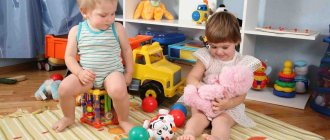Expecting a child is always full of joyful dreams, plans and hopes. Parents imagine their future life with their baby in bright colors. The son or daughter will be beautiful, smart and definitely obedient. The reality turns out to be somewhat different. The long-awaited baby is truly the most beautiful, smartest and most loved, and even sometimes obedient. However, closer to two years, the baby’s character begins to change. So much so that parents stop recognizing their child.
It becomes extremely difficult to cope with a child. Just recently, so sweet and flexible, he becomes capricious, hysterical and strives to do everything his own way. Of course, parents are aware that between two and three years the child enters his first transitional age.
Psychologists call this period the “two-year-old crisis.” He is still a very small child - 2 years old. He often freaks out and is capricious. However, this knowledge does not make it any easier. Life next to the little tyrant becomes simply unbearable. The baby, so obedient and sweet, suddenly becomes stubborn and capricious. Hysterics arise many times and out of nowhere. Moreover, if the child has set out to get what he wants, then it will no longer be possible to distract him by switching his attention to something else. The kid will stand his ground until the last.
Parents' confusion
Most parents are unprepared for such changes. What happens to the child takes them by surprise. Even if the baby has an older brother or sister and the parents have already gone through something similar, a nervous child who always throws tantrums creates an unbearable atmosphere in the house. Parents, frightened by the thought that their baby may have serious health problems, seek help from experienced friends. However, few people decide to turn to a specialist and get advice from a child psychologist.
The advice given by ordinary people in such cases is of the same type. Most are inclined to think that the child simply needs to be “asked the right way” so that he knows how to behave. However, such methods are not beneficial. The child becomes nervous and freaks out even more, literally leading loved ones to a nervous breakdown with his behavior.
Signs of hysteria
Children cannot stand it; due to their age, they begin to cry and throw hysterics at the slightest sign of discomfort.
The following signs will help you recognize a tantrum in a child:
- an outburst of uncontrollable anger;
- tears;
- loud, hysterical screams;
- irritation.
The child at this moment cannot control himself, causing rage and anger in the parents, since the older generation is confident that the baby has everything necessary for happiness. If the situation occurs on the street, then it is aggravated by the intervention of “sympathetic” passers-by who ask to calm the child down or reproach the parents for raising him incorrectly. Wanting to calm the baby down, mothers fulfill any of his demands, just so that the child calms down. And quick-witted children quickly understand how they can always get what they want. They begin to use whims, which, unlike hysteria, are most often conscious and used to achieve a goal.
The child will want to test his parents’ strength, starting to cry and be capricious whenever he fails to get what he wants “in a good way.” At this moment, it is very important to show restraint, not to let the baby feel power, otherwise he will continue to achieve his goal with hysterics, and the system of norms and rules will be greatly shaken.
What should parents do?
Not paying attention is perhaps the most sensible advice that can be given to parents who are going through their child’s first crisis with them. It is worthwhile to forget for a while about what is right and wrong, and allow the child to gain his own experience. Within reason, of course.
“I myself” is the phrase parents now hear most often. I’ll dress myself, I’ll eat myself, I’ll go for a walk myself. And it doesn’t matter that it’s +30 outside, but the child wanted to wear warm leggings outside. Negotiations with a stubborn baby will end in violent hysterics. The best thing to do in this situation is to simply allow your child to wear what he wants. Let him go outside in warm leggings. Just bring light clothes with you, and when your baby gets hot, change him. Along the way, he explained that the sun was shining now, and he needed to dress lighter.
A similar situation occurs at lunchtime. A child may want to eat sweet semolina porridge, dipping a salted tomato into it. Trying to feed him “correctly” will only lead to him refusing both. Let him eat what he wants and how he wants. If you can't look at it, just don't look at it.
Give your child more freedom and don't treat him like a toy. He is a person just like you, and he also has the right to make mistakes. Your task is not to protect him from all troubles, but to help him gain his own life experience. Of course, it is much easier to dress a child yourself than to wait for him to do it himself. Just take a little more time to get ready. In addition, try to listen to the opinion of the child himself. After all, he is also a person and has the right to be listened to. If it's lunch time and your child refuses to eat, then most likely he is not hungry yet. Meet him halfway. Most likely, he will soon get hungry, and you will have no problem feeding him.
Reasons for changes in child behavior
Mothers begin to rack their brains: what caused the bad behavior? What was missing in upbringing?
It seems like some kind of tension is building up and spilling out in this way. (Echomama) Some “tantrums,” in my unprofessional opinion, are caused by the fact that the child has nowhere to dump his energy, just to “go wild.” (Irkin) Maybe we paid too much attention to the eldest, if that happens. (Natalie)
As a rule, mothers beat themselves up in vain. The reason for the deterioration of behavior is different: the baby is entering adolescence, mastering a new system of relations with the outside world. At this age, the desire for independence increases, the desire to cope with simple tasks without the help of parents. Of course, such a desire should be welcomed. But the cost of this period is hysterics, when the child feels that his personality is being infringed upon.
If she wants something, but she can’t give it to her, she makes a face and starts wildly crying and shoving, which immediately stops if she gives in. For now, I give in or try to distract (it’s getting more and more difficult). But I’m terribly afraid that she will get used to the fact that with the help of such a howl you can get everything. (Anka)
This mother's fears are not unfounded. Psychologists say that at the age of one and a half to two years, a child begins to explore the boundaries of what is permitted. And he needs these boundaries, without them he ceases to feel safe. I will quote a fragment from the article “This Terrible Manipulator” from the magazine “Ego”.
“The baby tries to interact with the world and observes the results. If the reaction of the external environment is repeated several times, it is recorded in memory as normal. In the future, trying to make sure of his own safety, the baby pulls the usual strings and waits for the usual results. This is a sign for him that everything is okay. Over time, the child MUST encounter environmental resistance. Receiving no resistance, he subconsciously feels that something is wrong. In the end, he perceives this as a kind of danger. It is important to understand that a child who is hysterical and demanding something is not at all focused on results. His problem is that he needs resistance from others in order to feel a sense of security, but is not able to recognize and solve this problem on his own.”
Consciously or unconsciously, parents are looking for ways out of a crisis situation. Everyone has their own recipes. Some lock the child in the nursery with a recommendation to think about his behavior, or simply go to another room, letting him know that he has no audience. Some children need a stern parental shout to calm down. It can be very effective to explain what a child feels, but does not yet know how to express in words: “I understand, you are tired, you are angry...”
We patiently “drilled into it” that getting what you want without shouting is much more likely than throwing a tantrum. Children are no more stupid than us - logic is quite accessible to them. The child cannot cope with the situation on his own, and from powerlessness he sobs and falls to the floor. And if his parents also yell at him, then this does not help matters at all. Try to negotiate on equal terms. Look at the baby not “from top to bottom,” but sit down next to him: “Let’s think together what we should do.” (Marie)
Before things get hysterical and the child somehow reacts to the words, I say: “You’re crying, but I just can’t understand what you want. And this makes me upset. Calm down and tell me, and we’ll think together about what can be done.” (Irkin)
Establish contact with your child through play
Games for 2-year-old children are the main way of interacting with the outside world. To the question: “What are you doing?”, a child of 2-3 years old will probably answer: “I’m playing.” The child plays constantly. If he has toys, he will play with them. If there are no toys, he will invent them for himself.
Parents often complain that their child has a lot of toys, but almost never plays with them. Most often this happens when toys are lying around, disassembled and broken. The child simply forgets about them.
In order for a child to remember his toys, they must be in sight. To do this, it is best to keep them on open shelves. It is better to place large toys on the floor so that the baby can easily reach them. Place medium-sized toys directly on the shelf. This is where they will look most attractive.
Place all kinds of small items like small cars, Kinder Surprise figurines, beautiful pebbles found on the street in small boxes. On top of each box, place one item from the ones it contains. This way the child will understand where whose house is.
How to calm down?
Let's consider the recommendations of experts to help deal with the most difficult question: how to calm a child who is freaking out, hysterical, screaming and crying, demanding to buy him a toy? Some children even lose control of themselves and start banging their heads against the wall. The situation is very difficult, especially if everything happens in a clinic or public transport. How to be?
- Above all, experts urge keeping it brief. In this state, the child cannot perceive long parental speeches and does not delve into their meaning. Therefore, you need to speak to your baby strictly, clearly and concisely.
- A calm tone and soft but confident intonation are the best helpers in this case.
- You cannot give up, deciding to fulfill a whim, just to calm the baby down, promising yourself that next time the mother will be more persistent. The solution to the problem cannot be postponed.
- It is unacceptable to respond to a child’s aggression with aggression; parents need to show restraint and patience. Moreover, physical punishment should not be used.
- If the situation allows (mother and child are at home), it is very advisable to leave him alone with his tears, but under control. The child will understand that he has “lost a viewer” and will stop crying and screaming, quickly lose interest in the whim and switch to something else.
To some parents, the latter measure may seem unnecessarily harsh, but it is not. Very often, if one child takes a toy from another, the offended child will try to protect his property. But if an adult is nearby, he will run to complain, maybe even throw a tantrum so that someone else will solve his problem. By allowing the child to remain alone, a thoughtful parent will take a step towards becoming his independent and independent personality.
After a tantrum, it is important to take the child in your arms or hug, talk to him tenderly so that he does not have the feeling that his mother has stopped loving him. But the system of prohibitions must be strictly observed. At the same time, it is very important that one parent does not violate the prohibitions of the other (for example, dad gives the child chocolate, although mom strictly forbade it). This shouldn’t happen, both should be “on the same team”, support each other, and all disagreements should be resolved in the absence of the baby.
Do not give your child all toys at the same time
If a child does not see all his toys at once, then he will remain interested in them longer. If there are too many toys, collect some of them and hide them. after some time they can be shown to the child. He will start playing with them with no less interest than with new ones. Of course, you should not hide those toys to which the child is very attached. Some should be stored where they are most often used. For example, your daughter's toy kitchen utensils can be stored in a special box in the kitchen. This will keep your own kitchenware safe.
Your son's toy tools can be kept next to his dad's. When your child asks for a hammer or drill, give him his own toy tool. It is better to store bathing toys in the bathroom, and it is better to place the ball he plays with outside in the hallway.
External manifestations of hysteria in children
Psychologists specializing in working with very young children consider the two-year-old crisis to be one of the key and most difficult stages of development. Frequent tantrums negatively affect his normal development and maturation. Hysteria is accompanied by the following signs:
- uncontrollable outburst of anger and hatred;
- loud hysterical screams;
- tears;
- irritation;
- despair.
At the moment when the child is at the peak of hysteria, parents often experience no less irritation: many of them believe that the baby has no reason to cry. Passers-by are constantly indignant and make comments to parents, reproaching them for their inability to raise their child, which makes the parents even angrier and feel helpless in the face of the situation.
At this time, the child experiences real despair. He uncontrollably desires or, on the contrary, does not want something, but does not feel either support or understanding from adults, and feels lonely. All this provokes a new round of hysteria and a new outbreak of aggression on the part of the parents. Parents rush to do everything to make the child calm down, giving rise to manipulation. Two-year-old children, like sponges, absorb every new situation in which they find themselves in order to use it as a model of behavior in the future, this is how their psyche works. Parents find themselves trapped in children's whims, considering their manifestations to be ordinary disobedience and bad manners, but meanwhile, for children everything is much more serious.
At the moment of hysteria, a child often ceases to control the motor skills of his body; in a fit of despair, he is ready to bang his head against the wall, and can seriously harm himself. Therefore, when persuasion and conversations with the baby do not help, and the manifestations of causeless hysteria become more and more serious, it is best to contact a pediatric neurologist.
Create activities for your child
Perhaps your child is constantly naughty because he is simply bored. He is still very small and cannot always figure out how to play with this or that toy. To keep your baby busy, have a special box for all sorts of interesting little things. At the right moment, you will remove a ribbon from the box, from which you can make a leash for a stuffed dog, in which he has already lost interest, or a scrap for a new dress for a doll.
During games, your baby tries to stay closer to you. In his games, he will gladly accept your offer of help, but he is unlikely to want to be told what to do. Games for 2-year-old children involve all kinds of research, experiments and new discoveries. You should not try to explain to him the purpose of this or that toy or rush to answer a question that he himself has not yet been able to clearly formulate. This way you can ruin everything. Try to give your child the opportunity to be a leader in his play and follow him.
Expert advice
Factors that can cause negative behavior in a child are quite diverse. Therefore, the advice of a psychologist involves, first of all, establishing the cause of whims and hysterics. Based on this, ways to solve the problem are determined.
- If the reason is overwork, you need to create a daily routine in such a way that the child has the opportunity to rest during the day.
- Excessive busyness of a child can also cause attacks of nervousness and whims. Some parents, with good intentions, enroll their son or daughter in various clubs or continuously teach them at home, which affects the psyche and leads to similar problems. You can cope only by normalizing the baby’s life and avoiding excessive stress.
- A common reason is rebellion against parental despotism. In this case, you need to allow the child to become more independent, give him the opportunity to dress himself, choose a suit for himself. It is important to ask his opinion about what to cook for dinner, where to go for a walk. Moreover, parents do not need to become obedient “servants” of their child; it is enough to show interest in his position and listen to his opinion.
- As soon as the child is about to cry, you can try to distract him with an easy-to-follow request.
Active listening can help your child deal with their own emotions and feelings. Parents can use the phrases “I see that you are upset because you broke the doll”, “I know that you are angry.” The child learns to understand himself and control his emotions.
Help your child, be his partner
Your baby may have an idea for something, but will not be able to carry it out due to the fact that his physical capabilities are still very limited. Help him, but don't do everything for him. For example, he planted a tree branch in the sand and now wants to water his “flowerbed.” Help him carry a jar of water to the sandbox, but do not pour the water yourself. After all, he wants to do it on his own. If you deprive him of this opportunity, then a scandal will inevitably arise. The child has not yet learned to correctly express his negative emotions, so hysterics often occur in children. 2 years is an age at which not all children can still speak properly. Unable to provide compelling arguments in defense of his position, the kid throws a tantrum.
Many games are simply impossible to play on your own. You cannot catch or roll a ball if there is no one to throw it, you cannot play catch if there is no one to catch you. Often children have to beg their parents for a long time to play with them. After much persuasion, they reluctantly agree, but after a few minutes they say: “Well, that’s enough, now play yourself.” Or, when agreeing to play, they announce in advance that they can only give the child 10 minutes. After this, the child does not so much play as he fearfully waits for the promised minutes to end and for him to be told: “That’s enough for today.” It’s clear that you won’t be able to play all day, but sometimes it’s worth pretending that you really want to. Give your child the satisfaction of finishing the game when they want. Games for 2-year-old children are their very life.
Age characteristics
Don't rush to scroll through this item! It may seem to you that psychology is a boring thing and not particularly necessary, but it’s not like that: this science has a direct relationship to the process of raising a child, especially to changes in his behavior. It will be easier for you to understand your baby and find a common language with him if you know exactly what is happening to him.
First of all, speech development. At 2 years old, a child turns into a sponge that absorbs everything he hears and tries to reproduce. This applies not only to people’s speech, but to everything he sees and hears on television and radio. From which a completely logical conclusion follows: if possible, control the speech of nearby adults and what your child is watching. Also during this period, children are able to understand the speech of adults and conduct short but meaningful dialogues, respond to requests and ask in return. But the vocabulary is still small.
Photo source: shutterstock.com
Also, at 2-3 years old, the baby learns to express and control his emotions, but, unfortunately, he is not always able to do this, since joy and anger come over him very suddenly. Carefully monitor his condition: support him in moments of showing love or kindness and calm him down when the baby is excited about something. In addition, we need to teach children to control their emotions and express them correctly, and most importantly, show them where the boundaries of acceptable behavior are, what can and cannot be done.
The most important characteristic of a 3-year-old child is egocentrism. This means the following: he believes that everything that happens in this world is directly related to him. That is, when playing and communicating with peers, which begins to gain momentum, he will proceed solely from his own interests. Egocentrism manifests itself in the need for attention from adults every second, without a break for food or sleep. This does not mean that the baby will necessarily grow up to be selfish, it’s just that he is looking for the support of an adult who can help if something happens. This also includes the children’s desire to show that he can do a lot on his own.
It is worth mentioning here the so-called three-year crisis. In fact, the topic of this difficult time is quite extensive; it needs to be analyzed separately. The bottom line is this: the baby begins to realize himself as an independent adult with his own “I”, his own needs and desires, who copes quite well without the support of an adult. And then he is faced with the fact that he cannot carry out everything he has planned on his own due to various circumstances, the main ones of which are the ubiquitous adults and such a young age. Indignation at this is expressed by various symptoms: stubbornness, aggression, protest, self-will, despotism, obstinacy and devaluation of the established order of things. Hysterical states in such a crisis are quite common.
What to do if your child is hysterical
No matter how carefully you treat a two-year-old child, sometimes situations arise in which it is impossible to avoid hysteria. Unfortunately, a small child (2 years old) often freaks out and is capricious. Sometimes he has tantrums. According to statistics, more than half of two-year-old children are prone to hysterics and outbursts of rage. For many, this happens several times a week. Children prone to hysterics are usually very restless, smart and know well what they want. They want to do a lot of things and have a very bad attitude towards adults’ attempts to prevent them from doing this. Having encountered an obstacle on his way, a small child (2 years old) often freaks out and is capricious, wanting to achieve his goal.
Having fallen into hysterics, the baby is unable to control himself. He doesn't see or hear anything at all. Therefore, all objects that get in his way usually scatter in different directions. The child may fall to the floor and scream loudly. When falling, it may hit the floor or furniture hard. Parents are usually perplexed; they don’t understand why the child is freaking out, because just now everything was fine. The baby may scream until he vomits. At the same time, parents find themselves in a state close to panic; they do not know what to do if the child is nervous and disobedient.
It is very difficult for parents to observe such pictures. Especially when the child turns very pale and it seems that he is about to lose consciousness. True, he won’t cause himself any serious harm this way. His body's protective reflexes will come to the rescue, forcing him to take a breath long before he can suffocate.
About the importance of the problem
Let's consider what is associated with regular whims, disobedience and hysterics at 2.5-3 years old. First of all, it is increased nervous excitability. Moreover, in some children it is observed from birth and represents personality traits, in others it arises with age under the influence of external factors (both the education system as a whole and specific events).
Such behavior can be observed on an ongoing basis or represent attacks that occur as a response to psycho-emotional stress that accumulates over time. It is extremely important for parents to understand these factors and solve the underlying problem, otherwise all this will carry over into adulthood and become the reason that the matured child will be considered nervous, intemperate, even aggressive.
It is interesting that some children are constantly hysterical, wanting to manipulate their parents, to force them to “dance to their tune.” Babies do something similar, trying to get their mother’s attention at any cost. Older children, at 2.7 years old, become much more cunning - they understand how others will react to one or another of their actions, and often very skillfully subjugate their parents.
How to help your child
First of all, you should try to organize the child’s life so that he does not have nervous overload. If a child has become nervous, the symptoms will be visible immediately. These are frequent outbursts of rage. When these outbreaks become too frequent, they will not lead to anything good. If you forbid something to a child or force him to do something that he is not very pleased with, then try to be as gentle as possible. Do not try to keep your child within strict limits. Trying to protect himself, the child will throw tantrums regularly.
Sometimes parents hope to improve the child's condition by giving him sedatives themselves. Moreover, they “prescribe” the drugs themselves on the advice of relatives and friends. This is strictly not recommended. Only a doctor can prescribe sedatives for children. 2 years is an age at which a child is still extremely vulnerable; uncontrolled use of medications can harm him.
If your baby is hysterical, watch him closely to make sure he doesn't hurt himself. During a tantrum, the child’s mental state is such that he may not remember what he did while he was rampaging. To prevent him from hurting himself, try to hold him gently. When he comes to his senses, he will see that you are next to him and the scandal he created has not changed anything. Soon he will relax and fall asleep in your arms. The little monster will turn into a baby who needs affection and consolation. After all, this is still a very small child (2 years old). He often freaks out and is capricious, but at the same time he desperately needs your love, affection and consolation.
There are children who absolutely cannot stand it when someone tries to restrain them during hysterical attacks. This only makes the hysteria worse. In this case, do not use force. Just try to make sure your child doesn't hurt himself. To do this, remove all breakable and easily broken objects from his path.
Don't try to prove anything to a hysterical child. Until the attack passes, absolutely nothing will affect him. If your child is hysterical, don't yell at him. It won't make any difference. Some parents, trying to bring the child to his senses, begin to beat him. Usually this not only does not calm him down, but, on the contrary, makes him scream even louder. In addition, you can miscalculate your strength and injure the baby.
Don't try to explain anything to a screaming child. In a state of extreme irritation, even an adult is difficult to persuade. And what can we say about a two-year-old child? After he calms down, don't start the conversation first. Many children perceive this as a concession, and the screaming may begin with a vengeance.
It’s better to wait until the child comes to you. If he approaches you, hug him, caress him and act as if nothing happened.
Often parents are horrified at the thought of their child “throwing a concert” in public. They are ready to make any concessions, as long as he does not become hysterical. This practice leads to completely opposite results. Children are very observant and know very well how to manipulate their parents. Don't be surprised if your child starts having tantrums regularly and in the most inappropriate places.
Let your child understand that he will not achieve anything from you with hysterics. If he became angry because you forbade him to climb a high ladder, do not allow this after he calms down. If before the start of the tantrum you planned to go for a walk with him, go as soon as there is silence and do not remind the child of anything.
Most children's tantrums are designed to have an audience. As soon as you go to another room, the screams miraculously stop. Sometimes you can see a rather funny picture: a child screams with all his might and rolls on the floor. As soon as he discovers that there is no one nearby, he becomes silent, then moves closer to his parents and begins his “concert” again.
Historians and whims. 2-3 years. Very useful article.
Children's hysteria. What does the child want to say?
Unfortunately, sooner or later, most parents are faced with the phenomenon of children's hysterics. The child screams, throws himself to the ground, hits his head on the floor, and does not respond to the requests and words of the adult. Parents are confused, what happened to the baby? How to behave so that the nightmare ends as soon as possible?
For some children, the period of hysterics passes quickly, for others it can last for years. Much depends on the behavior of the parents. If you treat hysterics calmly and do not indulge hysterical attacks, you can correct the situation quite quickly.
Hysterics and whims
It is important to distinguish between the concepts of “hysteria” and “whim”. The child deliberately resorts to whims in order to achieve what he wants, something forbidden or impossible at the moment. Whims, as well as hysterics, are often accompanied by crying, screaming, stamping feet, and throwing objects. Sometimes a child's whims are impossible to fulfill.
For example, a child asks for a chocolate bar that is not in the house or wants to go down the stairs when the elevator arrives.
The mother of a two-year-old girl says: “I prepared porridge with berries and tea in the morning, as she asked.” Girl: “I don’t want it with berries, I want it without anything.” Mom: “You yourself asked for berries, I made them for you.” Dad comes into the kitchen: “I’ll have some berries!” And he takes the plate. Daughter: “No!!! This is my plate, I will, go away!”
Tantrums are usually involuntary. The child cannot cope with emotions. A child's hysteria is accompanied by loud crying, screaming, beating his head on the floor, beating his fists on the surface, and scratching his face. In severe cases, there may be involuntary convulsions, the so-called “hysterical bridge,” when the child arches.
A child's hysteria is a strong emotional reaction, supported by irritation, aggression, and despair. During a hysteria, the child has little control over his motor skills, so he can bang his head against the floor or wall, feeling virtually no pain. The peculiarity of children's tantrums is that they arise in response to an insult or unpleasant news, intensify with the attention of others and can quickly stop after the attention disappears.
The mother of a two and a half year old boy says: “We were in the store. My son asked me to buy a car, I agreed. He played with it while we did the rest of our shopping. Then I saw another toy and began to ask for a new one. I said that today we will not buy any more toys. He threw the typewriter, screamed, stamped his feet, and threw himself on the floor. I didn’t try to persuade him and drove on with the cart, telling him that we hadn’t bought any delicious sweets yet. When he saw that I was choosing sweets without him, the hysteria stopped.”
Age of first tantrums
It's not often that parents can boast that their children have had no tantrums at all. According to scientists, about 90% of parents experience tantrums in children aged one to three years. More often, the first hysterics begin at one and a half years. The peak of capriciousness and stubbornness is considered to be 2.5 - 3 years, the so-called “crisis” period of three years. During a crisis period, hysterics can happen up to 10-15 times a day, for almost any reason. At four years old, such behavior is considered rare; the child is able to express his feelings and emotions in words.
Why do children throw tantrums?
Children grow up and develop their own desires and interests, which may differ from the desires and interests of adults. If a child fails to achieve his goal, he experiences anger and irritation. Hysteria occurs when the interests of the child and parents collide. There are typical situations that lead to hysterics and scandals in the family. If the child:
- cannot express his feelings and desires in words; - plays with toys that are not suitable for his age and make him unsuccessful in the game; - does not get what he wants from others; - breaks away from an interesting activity; - overworked and tired; - wants to attract the attention of adults.
How to avoid hysteria?
The child learns to manage his behavior and emotions. But sometimes, he loses his composure, which can lead to hysterics. While watching your baby, try to understand what condition indicates an approaching hysteria. This may include pursed lips, snoring, or a slight whimper. If you notice any signs, try to redirect your child's attention to something interesting. Offer another toy, a book, go to another room, show what is happening outside the window. This technique can only be effective when hysteria has not yet flared up. If passions are already running high, then this method will not bring results.
Use various techniques to help prevent tantrums in children:
• Complete rest. Try to put your child to bed on time for daytime and nighttime sleep. Don't get overtired. If you see that your child is tired of playing, invite him to read or draw. Don't go to the store if your child is hungry. Young children do not yet know how to control their state of fatigue; the task of adults is to monitor the child’s condition and prevent overwork. • Clarifying the child's feelings. Name the child’s feelings and make it clear that you share them: “I understand that you are angry,” “I think you are tired, we walked a lot today,” “You were probably offended because the boy didn’t give you the car,” “Maybe you are angry because you didn’t get any candy,” etc. This will help your baby learn to talk about his feelings and control them. Make it clear that, despite feelings, there are certain limits: “I understand that you are angry, but you can’t shout in the store.” The child must know that there are situations in which such behavior is not acceptable. • Time for games. It is very important that the baby has enough free time to play, when no one distracts or interferes with the gameplay. • “Help me do this myself.” Don’t try to do everything for the child, show that he is already an adult and can cope with difficulties on his own, you will only encourage him to do this. Help you climb a hill, holding your hand, or teach you how to build a house out of blocks. • The right to choose. Give your child the right to choose. A child who can make his own choices feels that he is respected and taken into account. The choice should be clear to the child (what to eat for breakfast, what to play, go to the park or playground). There is no point in asking a child whether he wants to go to kindergarten or not. This decision is made by the parents. But he is quite capable of choosing between a yellow and green T-shirt. If you offer a choice, then take into account the child’s opinion, do not impose your option. The child chose a yellow T-shirt. You shouldn’t say: “I think green will be better.” If there is no real choice, do not create an appearance, just report what will happen now: “We are going to the store.” • Use requests. If the child starts crying, ask him to come to you and give him something in his hands (it could be a toy, handkerchief, book, etc.). Ask to show the book to dad, take a handkerchief to grandma, or find a “house” for a toy.
How to behave during a hysteria?
Usually the impetus for the onset of a hysteria is a whim: “I want it, give it to me, buy it, I won’t, go away...” If it was not possible to prevent the hysteria and it started, do not try to calm the child down at this moment, persuade, scold or shout, this will become an incentive to continue hysterics.
• Do not leave your child alone, this can frighten the baby. Be nearby, within the child's field of vision, and try to remain calm and confident. • If your child throws a tantrum to get what he wants, don't give in. By fulfilling the child's wishes at the moment of hysteria, you thereby reinforce this form of behavior. The child will continue to use tantrums to get his way. If once in response to a hysteria you allow someone to take something that is not allowed, you can be sure that the hysteria will happen again and again. • Avoid physical punishment. This will only worsen the child’s condition; it turns out that he is being punished for something that he cannot cope with. Mind your own business and ignore the hysteria. The child will understand that this does not bring the desired attention and in the future it is not worth wasting his energy. • Use tactile contact. Try to hug your child tightly and hold him in your arms for a while, repeat that you love him, even in those moments when he is angry, but you are upset when he screams loudly and throws himself on the floor. But you should not forcibly hold the child in your arms; if he breaks away, it is better to leave him on the sofa or on the floor. • Don't let your child control you. If you need to leave, and the child, not wanting to stay with dad or grandma, throws a tantrum, calmly say goodbye to him and leave the house. The longer you delay the moment of leaving, the longer the hysteria will be.
Tantrums in public places
Not all parents are able to withstand a tantrum in a public place. It’s easier to give in and give what you want, “if only you’d stop screaming.” But this method is dangerous. Try not to pay attention to the judgmental glances of strangers. If you give in now just to avoid a public scandal, be prepared to do the same in the future. You refused to buy a new toy, don’t give up right away. Let the child be indignant, stamp his feet and express dissatisfaction. If you confidently state your decision, the child will understand that hysteria will not achieve anything. Tantrums in public places are usually intended not so much for the mother as for the public. Be careful when involving others in this process. It’s better to do without their help and just wait out the outbreak. Yelling when no one is paying attention is no fun at all.
When it's all over
After the passions have subsided, do not deny the child affection, take him in your arms and calm him down. Talk about what upset your baby so much. Tell him that you love him very much and you are pleased to talk to him when he is calm. The child must learn to express his desires using words.
Parental behavior
Often children's hysterics and whims are the result of the erroneous behavior of parents. The child is allowed everything, everything is possible, he doesn’t even know about the existence of the word “no”. Determine a list of prohibited and permitted things and adhere to the established order. Children are very observant and smart. They understand that they can beg candy from grandma if mom forbids it. Or you need to go for a walk with your grandfather, he will definitely buy a toy. Try to ensure that one of the parents does not cancel the other’s prohibitions. If mom didn’t allow it, then it’s not allowed. If dad told you to put away the toys, then you have to put them away.
Do I need to contact a specialist?
If a child's whims and hysterics are constant, this may be a consequence of a disease of the nervous system. Contact a pediatric neurologist if:
- a child holds his breath or loses consciousness during a hysteria; - tantrums become more frequent and aggressive; - the child continues to have tantrums after 4 years; - the child causes harm to himself and others; - hysterics are accompanied by nightmares, fears, and sudden mood swings; - hysteria ends with vomiting or shortness of breath, sudden lethargy and fatigue of the child. If everything is fine with the child’s health, then the problem lies in family relationships and the reaction of loved ones to the child’s behavior. Don't let children get what they want with tantrums. Be patient and find compromises. Most tantrums can be prevented by understanding their causes.
Sofya Pozdnyakova, child psychologist, Center for Children's Education and Culture "Overcoming" magazine for parents "Raising a Child", November 2012
link to source
When is it time to go to a child psychologist?
You should contact a psychologist if your child’s tantrums become too frequent and become protracted. In particular, they do not go away, even if the child is left completely alone. If parents have tried all the methods, but still cannot overcome tantrums, then it’s time to seek advice from a child psychologist. In order to find a good specialist, ask your friends who have already been helped by a child psychologist. Reviews will be a good guide for you. In addition, it is worth visiting a pediatric neurologist. This doctor will order the necessary examinations and, if necessary, prescribe sedatives for children. 2 years is the age at which natural herbal preparations are most often recommended.
Sometimes the reason for children's tantrums lies in family troubles and lack of agreement between parents. Even if parents never quarrel in front of the baby, the baby still feels the nervous atmosphere and reacts to it in his own way. As soon as they come to an agreement, calming their thoughts and feelings, the child’s tantrums immediately stop.
Being a child is just as difficult as being an adult. But time is still on our side. Very soon you will find that the two-year mark has been passed, and all the hysterics are far behind you.
When to contact a specialist?
There are situations when disobedience, crying and whims are a consequence of hyperkinetic syndrome - a mental illness. In this case, you will have to take professional help.
In addition, it is imperative to show the baby to a neurologist in the following cases:
- loss of consciousness or trouble breathing during a tantrum;
- vomiting after;
- lethargy, sudden apathy;
- The condition does not stop even when the baby is 4 years old.
These symptoms may indicate a serious illness, so they should not be ignored.
Almost all parents have to go through hysterics and crying, whims and tears, the main thing is to learn to understand their baby and react sensitively to the changes happening to him. Then there will be much fewer problems.
Parents' behavior and their main mistakes
Mothers, accustomed to the fact that their child is an extension of them, do not always have time to notice the moment when, at two years old, he begins to separate and show independent desires, different from those that his parents impose on him.
Constantly faced with unusual and uncontrollable reactions in children to habitual actions, when the baby freaks out about food, sleep, walks, mothers experience shock and no longer control the situation. With the help of hysteria, a child as young as two years old can try to determine the boundaries of what is permitted. For example, he doesn't want to eat soup because he prefers candy. The child’s mind lacks a socially formed way and system of eating food, and constantly sincerely does not understand why one cannot dine on chocolate. He demands that his wish be fulfilled, and the only weapons in his arsenal are crying, screaming and hysterics. It is as if he is testing the strength of his own parents, and if they give in, the boundaries of what is permitted expand. In other words, the parents’ incorrect behavior gives the child a reason and even provokes him into subsequent hysterics.
Despite the fact that the baby’s behavior and his whims are associated with the physiological processes of his development at two years old, in no case should you give in to whims and do everything the baby wants.
The hysteria will indeed subside, but next time the child will want to get something more and new, whims will appear more and more often, and hysterics will become more and more uncontrollable. The child must clearly know what “no” and “no” are.
When babies start crying, mothers try to distract them: they begin to feed them, entertain them with toys, show them some fundamentally new look, etc. This method works because at a very tender age children are not able to think about two radically different things at the same time.
At the age of two, a child sincerely does not understand why his parents, in response to his demand to buy him a new toy, show a beautiful Christmas tree in the center of the sales area. He accepts the existence of this beautiful tree, but this does not stop him from wanting the toy. The distraction method is useless and can even make the situation worse.










